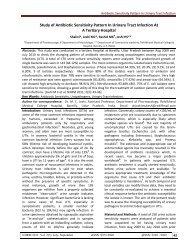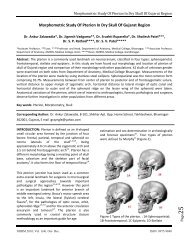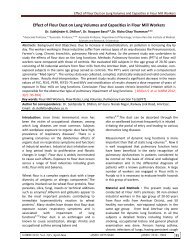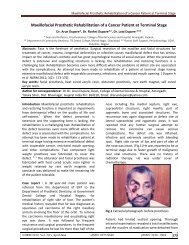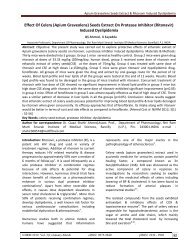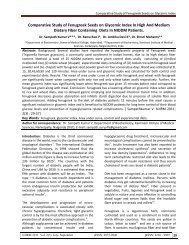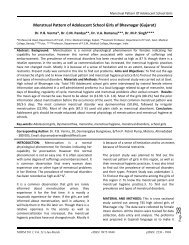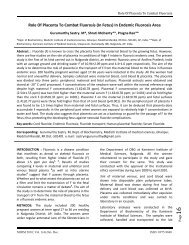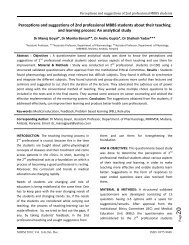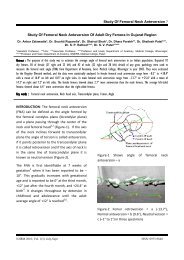Study Of Carrying Angle 28 - njirm
Study Of Carrying Angle 28 - njirm
Study Of Carrying Angle 28 - njirm
Create successful ePaper yourself
Turn your PDF publications into a flip-book with our unique Google optimized e-Paper software.
<strong>Study</strong> <strong>Of</strong> <strong>Carrying</strong> <strong>Angle</strong> <strong>28</strong><br />
<strong>Study</strong> <strong>Of</strong> <strong>Carrying</strong> <strong>Angle</strong> And Its Correlation With Various Parameters<br />
Dr. Srushti Ruparelia*, Dr. Shailesh Patel**, Dr. Ankur Zalawadia*, Dr. Shaival Shah*,<br />
Dr. S. V. Patel****<br />
*Assistant Professor, **Associate Professor, Department of Anatomy, Medical College, Bhavnagar; ****Professor and Head, Department<br />
of Anatomy, GMERS, Medical College, Patan<br />
Abstract: The role of carrying angle in the sex determination and its cause of formation is a long debated issue in Anatomy and<br />
Anthropology. Most studies have focused on the question of cause of formation of carrying angle, difference in sex and age but little<br />
attention has been given to correlate the carrying angle with various parameters. Hence, an effort has been made to find out<br />
correlation of carrying angle with height, and length of forearm. For present study, total 333 (173 female & 160 male) asymptomatic,<br />
healthy students of Nursing School, Homeopathic Medical College, Ayurvedic College and Medical College belonging to various regions of<br />
Gujarat were selected. There ages ranged between 17 to 22 years. An improvised instrument goniometer was used for measurement of<br />
carrying angle. Height was measured in standing, erect, anatomical position from vertex to heel with bare foot. Vernier caliper of 12”<br />
was used to measure the length of forearm. According to the present study, height and length of forearm of the person are inversely<br />
related with the carrying angle. Greater carrying angle in female is considered as secondary sex characteristic. Knowledge of the<br />
carrying angle helps in paediatric elbow surgery. It also helps orthopedic surgeon for correction of cubitus varus deformity occurring<br />
after malunited supracondylar fracture of humerus.<br />
Key words: <strong>Carrying</strong> angle, height, length of forearm, puberty<br />
INTRODUCTION: The carrying angle is defined<br />
as the acute angle made by the median axis of<br />
the arm and that of fully extended & supinated<br />
forearm & thus it measures the lateral obliquity<br />
of the forearm. The role of carrying angle in the<br />
sex determination & its cause of formation is a<br />
long debated issue in Anatomy & Anthropology.<br />
According to Mall 1 the axis of the elbow joint is<br />
set obliquely at nearly 84° of both the humerus<br />
& ulna which is also agreed upon by Jones 2 .<br />
Langer 3 was of the opinion that the obliquity of<br />
trochlea to the shaft of the humerus is the<br />
cause. Kapandji 4 explained that the angle is<br />
formed as a result of trochlear groove being<br />
vertical anteriorly but on the posterior aspect it<br />
runs obliquely distally & laterally. This results in<br />
formation of carrying angle in extension when<br />
posterior aspect of the oblique groove makes<br />
contact with the trochlear notch of ulna & the<br />
angle is marked during flexion when trochlear<br />
notch lies on the vertical groove in the anterior<br />
aspect. Last 5 suggested is that in the ulna a<br />
curved ridge joins the prominence of the<br />
coronoid & olecranon process which fits the<br />
groove in the trochlea of the humerus. The<br />
obliquity of the shaft of ulna to this ridge<br />
accounts for most of the carrying angle at<br />
elbow. Decker 6 gave the same reason pointing<br />
out that the inner lip of trochlea of humerus is<br />
a ridge (groove) which is much deeper distally<br />
anteriorly so that ulna (with the forearm) is<br />
deflected in full extension by this ridge. William<br />
et al 7 considered the medial edge of trochlea of<br />
humerus party responsible as it projects nearly<br />
6 mm below the lateral edge & the obliquity of<br />
the superior articular surface of the coronoid<br />
process which is not set at right angle to the<br />
shaft of ulna.<br />
Most studies have focused on the question of<br />
cause of formation of carrying angle, difference<br />
in sex and age but little attention has been<br />
given to correlate the carrying angle with<br />
various parameters. Hence, an effort has been<br />
made to find out correlation of carrying angle<br />
with Height, and length of forearm.<br />
MATERIAL & METHODS: In present study total<br />
333 (173 female & 160 male) asymptomatic,<br />
healthy students of Nursing School,<br />
Homeopathy College, Ayurvedic College and<br />
Medical College belonging to various regions of<br />
Gujarat were selected. There ages ranged<br />
NJIRM 2010; Vol. 1(3). July-Sept. ISSN: 0975-9840
etween 17 to 22 years. Medical & paramedical<br />
students of this age group were selected as<br />
subject because of easy availability.<br />
Figure‐1 Shows carrying angle measurement<br />
An improvised instrument goniometer is used<br />
for measurement of carrying angle. The fixed<br />
arm of which could be placed on the median<br />
axis of the upper arm, the movable arm<br />
adjusted as to lie on the median axis of forearm<br />
<strong>Study</strong> <strong>Of</strong> <strong>Carrying</strong> <strong>Angle</strong> 29<br />
& the angle read on the goniometer. Bicipital<br />
groove, biceps brachii tendon at its insertion &<br />
palmaris longus tendon at the wrist were<br />
palpated & marked as anatomical landmarks to<br />
demarcate the median axes of the arm & the<br />
forearm respectively. Measurement of carrying<br />
angle was taken on the left side as well as on<br />
the right side to find out difference on both<br />
sides if any (Figure‐1). Stature meter is used to<br />
measure the height. Height was measured in<br />
standing, erect, anatomical position from<br />
vertex to hill with bare foot. Vernier calliper of<br />
12” is used to measure the length of forearm.<br />
Medial epicondyle & styloid process of the ulna<br />
are used as landmark. Distance between these<br />
two points is recorded as length of forearm<br />
(length of ulna).<br />
All the parameters were measured in<br />
centimetres except the carrying angle was<br />
measured in degree. Three consecutive<br />
readings were taken and the mean was<br />
recorded.<br />
OBSERVATION & RESULTS: Cross sectional<br />
study of 333 was conducted at medial college,<br />
Bhavnagar. Out of them 173 students are<br />
female & 160 students are male. Obtained data<br />
are shown in Table‐1 and 2.<br />
Table‐1 Shows values in range mean and standard deviation of carrying angle, length of forearm<br />
and height<br />
Measurement<br />
<strong>Carrying</strong> <strong>Angle</strong> (in degree) Length of forearm (in cm) Height (in cm)<br />
Sex Side Range Mean±SD Range Mean±SD Range Mean±SD<br />
Male<br />
Right<br />
Left<br />
5-11 6.90±1.25<br />
6.78±1.38<br />
19-27 22.70±1.21<br />
22.69±1.22<br />
150-177 166.87±5.<strong>28</strong><br />
Female Right 6-18 11.85±2.27 20-<strong>28</strong> 24.96±1.30 140-173 153.94±5.84<br />
DISCUSSION: A study of <strong>Carrying</strong> angle and its<br />
value in relation to the age has been carried<br />
out by many workers. Most other studies have<br />
focused on the question of carrying angle<br />
difference in sex. Potter 8 , Atkinson & Elftman 13<br />
and R Purkait & H Chardra 14 started that the<br />
carrying angle is greater in females than in<br />
males & this difference has been considered to<br />
be a secondary sex characteristics. The present<br />
study deals with the observation on carrying<br />
angle and its correlation with height and length<br />
of forearm.<br />
NJIRM 2010; Vol. 1(3). July-Sept. ISSN: 0975-9840
Table‐2 Shows comparison of average<br />
carrying angle in male and female by<br />
workers and present study<br />
<strong>Study</strong> by <strong>Carrying</strong><br />
angle –<br />
Male<br />
<strong>Carrying</strong><br />
angle –<br />
Female<br />
Potter 8<br />
6.83° 12.65°<br />
Baughman et al 9 11.0° 15.0°<br />
J Rai et al 10<br />
13.26° 17.91°<br />
Keats et al 11<br />
11.0° 13.0°<br />
G. N. Khare 12<br />
13.56° 16.92°<br />
Present <strong>Study</strong> 6.9° 11.8°<br />
Table‐1 shows values in range, mean and<br />
standard deviation of the carrying angle,<br />
length of forearm and height. The average<br />
carrying angle of male is 6.9° and of female is<br />
11.8° in present study. Results obtained in<br />
present study are quiet comparable with<br />
results of other workers study.<br />
Results obtained by Potter 8 and present study<br />
are almost similar. From the above study we<br />
have observed that the carrying angle in<br />
female is greater than male. In the present<br />
study 63.3 percent of female height ranges<br />
between 150–160 cm, average 153.9 cm,<br />
where as major population among male<br />
students (61.3%) height vary form 160 – 170<br />
cm, average 166.8 cm.<br />
Average Right forearm length is 24.96 cm in<br />
male and 22.70 cm in female whereas on the<br />
left side this value is 24.96 cm in male and<br />
22.68 cm in female. Difference of the length<br />
of forearm of right and left side is statistically<br />
insignificant, whereas difference in the length<br />
of forearm in the male and female is<br />
statistically significant. From the present<br />
study, it is observed that the height and<br />
forearm length both are more in males than<br />
females. In contrast to this average carrying<br />
angle is more in females than males. We have<br />
proposed a new explanation for greater<br />
carrying angle in females than in males. When<br />
the forearm is pronated the proximal part<br />
angulates. The medial part of the trochlear<br />
<strong>Study</strong> <strong>Of</strong> <strong>Carrying</strong> <strong>Angle</strong> 30<br />
notch moves more away from the humeral<br />
articular surface than the lateral part.<br />
Therefore the medial flange of trochlea is not<br />
compressed & grows more than lateral flange.<br />
If the height of a person & therefore length of<br />
ulna is lesser, then because of shorter lever<br />
arm, the proximal end has to angulate more<br />
in order to bring the hand in pronated<br />
position for routine work. Therefore in a<br />
shorter person the medial part of trochlear<br />
notch of ulna goes more away from the<br />
medial flange of trochlea which can now grow<br />
more than in a person with longer forearm,<br />
leading to greater carrying angle.<br />
The carrying angle develops in response to<br />
the pronation & is dependent on the length of<br />
the forearm bones greater the length of the<br />
forearm bone lesser is the angulation of<br />
proximal articulation of proximal articular<br />
surface, therefore lesser is the carrying angle<br />
(Figure‐2). From the present study it is clear<br />
that the height & length of the forearm are<br />
directly related to each other. Length of the<br />
forearm in female is 22.7 cm on right side and<br />
22.6 cm on left side where as in male this<br />
value is 24.9 cm on both sides which is<br />
inversely related to the carrying angle (Figure‐<br />
3).<br />
Figure‐2 Scattered diagram showing<br />
correlation between height and carrying angle<br />
Olecranon‐coronoid angle exhibiting high<br />
sexual dimorphism may be one of the causes<br />
of sexual dimorphism observed in carrying<br />
NJIRM 2010; Vol. 1(3). July-Sept. ISSN: 0975-9840
angle. Distal part of the humerus particularly<br />
trochlea & proximal part of the ulna play<br />
major role in the causation of carrying angle.<br />
<strong>Carrying</strong> angle<br />
20<br />
18<br />
16<br />
14<br />
12<br />
10<br />
8<br />
6<br />
4<br />
2<br />
0<br />
17 19 21 23 25 27 29<br />
Forearm lenght<br />
Male<br />
Female<br />
Figure‐3 Scattered diagram showing<br />
correlation between forearm length and<br />
carrying angle<br />
<strong>Carrying</strong> angle helps in keeping the forearm<br />
away from the side of the pelvis when the<br />
upper limb swing during walking is also wrong.<br />
The carrying angle is only formed when the<br />
forearm is fully supinated & extended at<br />
elbow. It disappears in pronation or flexion at<br />
elbow. Therefore if the carrying angle is not<br />
present & does not help in any way in keeping<br />
the forearm away from the side of the pelvis<br />
during walking. Present study has no data to<br />
compare the obtained results. It may be<br />
considered as secondary sex characteristics in<br />
female because according to the study of<br />
some workers there is no difference in the<br />
carrying angle in male & female up to the<br />
puberty. But in the female, it is increased<br />
after puberty.<br />
CONCLUSION: According to the present <strong>Study</strong>,<br />
Height of the person is inversely related with<br />
the carrying angle. Average height of female<br />
is 153.9 cm and in male it is 166.8 cm. There<br />
is significant difference between male &<br />
female carrying angle, in female it is 11.8<br />
degree and in male it is 6.9 degree. Greater<br />
carrying angle in female is considered as<br />
secondary sex characteristic. From the<br />
present study it is clear that the height &<br />
length of the forearm are directly related to<br />
<strong>Study</strong> <strong>Of</strong> <strong>Carrying</strong> <strong>Angle</strong> 31<br />
each other. Length of the forearm in female is<br />
22.7 cm on right side and 22.6 cm on left side<br />
where as in male this value is 24.9 cm on both<br />
sides which is inversely related to the carrying<br />
angle. It may be considered as secondary sex<br />
characteristics in female because according to<br />
the study of some workers there is no<br />
difference in the carrying angle in male &<br />
female up to the puberty. But in the female, it<br />
is increased after puberty.<br />
REFERANCES:<br />
1. Mall FP. On the angle of the elbow. Am<br />
Anatomy 1905;4:391‐404.<br />
2. Jones FW. 1953 Bachanan’s manual of<br />
Anatomy London : Bailliere Tindall and cox<br />
Ltd.<br />
3. Langer. On the angle of the elbow. Am J<br />
Ant 1905;4:391–404<br />
4. Kapandji I A 1970 The Physiology of Joints<br />
5. Last RJ 1978 Anatomy – regional and<br />
applied 6 th edn London. Churchill<br />
Livingstone Longman.<br />
6. Decker Gog 1986 Lee Mce Gregor’s<br />
synopsis of Surgical Anatomy 12 th Edn.<br />
Bristol : John Wright and Sons Ltd.<br />
7. Williams A, Standring S, Ellis H, Haely J<br />
2005 Gray’s Anatomy.<br />
8. Potter HP. The obliquity of the arm of the<br />
female in extension and the relation of the<br />
forearm with the upper arm in flexion. J<br />
Anat Lond 1895;29:488‐493.<br />
9. Baughman FA, Higgins JV, Wadsworth TG,<br />
Demaray MJ. The carrying angle in sex<br />
chromosome anomalies. JAMA<br />
1974;230:718<br />
10. Rai J, Parkash S, Singhal V. <strong>Carrying</strong> angle in<br />
Indian girls and boys. Indian journal of<br />
orthopaedics 1980;14:170‐174<br />
11. Keats TC, Teeslink R, Diamond AE,<br />
Williams JH. Normal axial relationship of<br />
major joints. Radioilogy 1996;87:904‐907<br />
12. Khare GN, Rai SK. <strong>Carrying</strong> angle in boys<br />
and girls of eastern part of India.<br />
1918;32:7‐13<br />
NJIRM 2010; Vol. 1(3). July-Sept. ISSN: 0975-9840
13. Atkinson WD, Elftman H. The carrying<br />
angle of human arm as a secondary sex<br />
character. Ant Rec 1995;91:49‐53.<br />
<strong>Study</strong> <strong>Of</strong> <strong>Carrying</strong> <strong>Angle</strong> 32<br />
14. Purkait R. An Anthropometric investigation<br />
to the probable cause of formation<br />
carrying angle. A Sex indicator. JIAFM<br />
2004;26:14‐20<br />
NJIRM 2010; Vol. 1(3). July-Sept. ISSN: 0975-9840



